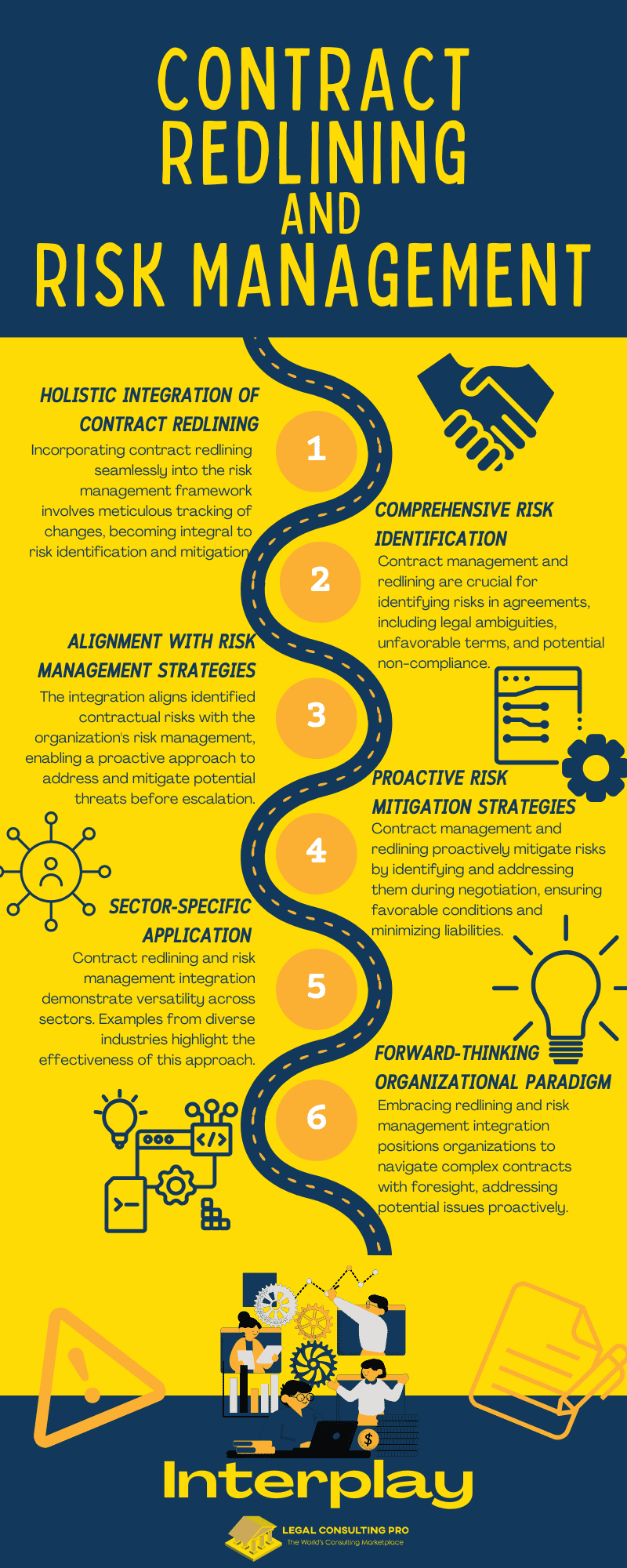In the dynamic landscape of business, the twin pillars of contract redlining and risk management stand as essential guardians of operational efficiency and success. Contract management and redlining involve the meticulous review and editing of contractual agreements, ensuring clarity, compliance, and mitigation of potential risks. Concurrently, risk management is the strategic process of identifying, assessing, and mitigating potential threats to a business’s objectives. The intersection of these two practices is not merely coincidental but forms a critical nexus for a robust and comprehensive approach to business operations.
This article delves into the symbiotic relationship between contract redlining and risk management, exploring how their integration becomes a catalyst for enhancing overall business strategies. By carefully dissecting contractual nuances through redlining, businesses not only fortify legal compliance but also unveil potential risks embedded in agreements. The aim here is to decipher how this integrated approach transforms risk management from a reactive stance to a proactive, strategic tool. Through this exploration, we unravel the synergies that empower businesses to not only navigate the complexities of contracts but also preemptively manage risks, fostering resilience and agility in an ever-evolving business environment.
Understanding Contract Redlining
Contract redlining is a pivotal process in the negotiation and modification of contracts, playing a crucial role in shaping the final agreement between parties. This method involves tracking changes made to a contract, often using red font or other distinctive markings, to signify modifications, additions, or deletions during the negotiation phase.
The significance of contract management and redlining lies in its ability to align contractual terms with the overarching objectives of the involved parties. Through this iterative process, stakeholders can collaboratively refine and tailor contractual language to better suit their respective needs and expectations. This alignment is essential for fostering mutual understanding and preventing misunderstandings that may arise during the execution of the agreement.
Moreover, contract redlining serves as a powerful tool in risk management. By visually highlighting alterations, both subtle and substantial, parties can readily identify potential risks and discrepancies. This transparency facilitates a thorough review, allowing parties to address and mitigate risks before finalizing the contract. In essence, understanding and effectively utilizing contract management and redlining is a cornerstone in the art of contract negotiation, ensuring that agreements not only reflect the intentions of the parties but also mitigate potential challenges that may arise throughout the contractual relationship.
The Landscape of Risk Management
Defining Risk Management
Risk management is a strategic and systematic approach that organizations adopt to identify, assess, and mitigate potential risks that could impact the achievement of their objectives. It encompasses a wide array of activities aimed at understanding, evaluating, and responding to uncertainties that may affect organizational success.
Significance in Organizational Strategies
The broader significance of risk management lies in its integral role in organizational strategies. It is not merely a reactive measure but an integral part of strategic planning. Effective risk management ensures that organizations are equipped to navigate uncertainties, make informed decisions, and proactively protect their assets, reputation, and overall sustainability.
Key Components of a Robust Risk Management Framework
A robust risk management framework comprises several key components. Identification involves recognizing potential risks, assessment entails evaluating their impact and likelihood, while mitigation involves implementing strategies to reduce or eliminate these risks. Ongoing monitoring and communication are also essential components, ensuring that the risk landscape is continuously evaluated and communicated across the organization.
Proactive Nature of Risk Management
One of the central tenets of risk management is its proactive nature. Rather than waiting for risks to materialize, organizations actively anticipate and prepare for potential challenges. This proactive stance empowers them to respond swiftly, make informed decisions, and maintain resilience in the face of uncertainties.
In essence, the landscape of risk management is characterized by its strategic importance, encompassing a holistic framework that goes beyond reaction to proactively safeguard organizational objectives. By systematically addressing uncertainties, organizations not only enhance their resilience but also lay the foundation for sustainable growth and success.
The Interplay of Contract Redlining and Risk Management
The interplay of contract redlining and risk management forms a critical synergy in modern business practices. Contract redlining, the process of tracking and marking changes in contracts, seamlessly integrates with risk management to fortify organizational resilience.
Holistic Integration of Contract Redlining:
- Involves incorporating contract management and redlining seamlessly into the broader risk management framework.
- Redlining, the meticulous tracking of changes in contractual documents, becomes an integral part of risk identification and mitigation.
Comprehensive Risk Identification:
- Contract management and redlining play a pivotal role in identifying various types of risks inherent in contractual agreements.
- Risks may encompass legal ambiguities, unfavorable terms, or potential non-compliance with regulatory standards.
Strategic Alignment with Risk Management Strategies:
- The integration process revolves around aligning the identified contractual risks with the overarching risk management strategies of the organization.
- This alignment facilitates a strategic and proactive approach to address and mitigate potential threats before they escalate.
Proactive Risk Mitigation Strategies:
- Contract management and redlining serve as a proactive tool for risk mitigation.
- By identifying and addressing risks during the negotiation and drafting stages, organizations can renegotiate terms, ensuring more favorable conditions and minimizing exposure to potential liabilities.
Sector-Specific Application:
- The versatility of contract redlining and risk management integration is demonstrated across different business sectors.
- Examples from diverse industries, such as technology and finance, highlight the adaptability and effectiveness of this integrated approach.
Forward-Thinking Organizational Paradigm:
- Emphasis is placed on the forward-thinking nature of organizations that embrace the integration of redlining and risk management.
- This approach positions businesses to navigate complex contractual landscapes with strategic foresight, addressing potential issues before they become critical challenges.

Mitigating Legal and Business Risks Through Redlining
Contract management and redlining stand as a strategic cornerstone in mitigating legal and business risks, offering a nuanced approach to negotiation and agreement refinement. In the legal realm, redlining allows parties to highlight, revise, or comment on specific terms, ensuring clarity and alignment with legal standards. By pinpointing potential ambiguities or liabilities, redlining becomes a proactive measure to safeguard against legal pitfalls.
In the business domain, effective redlining plays a pivotal role in mitigating operational and financial risks. For instance, a supplier contract may undergo meticulous redlining to clarify delivery timelines, payment terms, or liability provisions. This precision is instrumental in averting disputes and fostering mutually beneficial relationships.
Successful risk mitigation through redlining is exemplified in various industries. In technology, redlining ensures robust intellectual property protection by defining ownership rights. In construction contracts, redlining helps delineate responsibilities, mitigating the risk of project delays or cost overruns. These examples underscore how redlining, when strategically applied, not only refines legal agreements but also acts as a proactive shield against potential business disruptions and legal entanglements. This collaborative process of negotiation and refinement emerges as a powerful tool in navigating the complex landscape of legal and business risks, ensuring agreements align with both parties’ interests while minimizing potential pitfalls.
Challenges and Solutions
Integrating contract redlining with risk management poses several challenges within the legal landscape. These are:
Challenges:
Version Control Complexity:
- Managing changes across multiple revisions introduces complexity in accurately tracking and documenting modifications made during the redlining process.
Real-time Collaboration vs. Data Security:
- Balancing the imperative for real-time collaboration among team members with the critical need to uphold stringent data security protocols.
Speed vs. Accuracy Dilemma:
- The pressure to expedite contract reviews poses a dilemma where there’s a risk of compromising the thoroughness required for effective risk management.
To address these challenges, implementing a robust version control system is essential.
Solutions:
Robust Version Control System:
- Implementation of a robust version control system is crucial to meticulously track changes, ensuring precision and transparency in the redlining process.
Collaborative Platforms with Tracking Features:
- Utilizing collaborative platforms with integrated tracking features ensures efficient team collaboration while upholding high standards of data security.
AI-driven Contract Analysis Tools:
- The integration of advanced AI-driven contract analysis tools automates and expedites the redlining process, minimizing errors and enhancing overall efficiency.
Communication and Training:
- Fostering a culture of effective communication and providing regular training sessions are vital for enhancing team proficiency in using updated software tools.
Phased Approach to Contract Review:
- Implementing a phased approach to contract review with designated checkpoints ensures a thorough risk assessment at each stage without sacrificing speed.
Best Practices:
Regular Training Sessions:
- Conducting regular training sessions ensures that team members are adept at leveraging the latest software tools and technologies.
Clear Processes and Checkpoints:
- Establishing clear processes and designated checkpoints within the contract review workflow is critical for meticulous risk assessment.
Technology Integration:
- Seamless integration of advanced technologies into the workflow streamlines processes, elevating overall efficiency in contract redlining and risk management.
By addressing these challenges with informed solutions and adopting best practices, organizations can harmonize contract management and redlining with risk management, fostering a secure, efficient, and compliance-driven legal workflow.
Conclusion
In conclusion, navigating the integration of contract redlining and risk management demands addressing challenges with robust solutions and embracing best practices. The intricacies of version control, real-time collaboration, and the speed versus accuracy dilemma underscore the need for a comprehensive approach. The synergy between advanced technologies, clear processes, and effective communication, especially facilitated by paralegal expertise, emerges as pivotal. Recognizing this intersection as a strategic imperative is not merely advantageous but fundamental for sustained success. Businesses are urged to prioritize this integration, fostering a secure, efficient, and compliant legal workflow that aligns seamlessly with contemporary demands and ensures enduring prosperity.
Similar blogs:
Mastering Confidentiality and Professionalism for Next-Level Contract Redlining!
Contract Redlining Best Practices







































